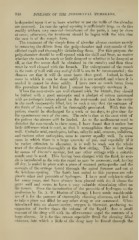Page 938 - My FlipBook
P. 938
948 DISEASES OF THE PERIDENTAL MEMBRANE.
is deposited upon it or to learn whether or not the walls of the alveolus
are necrosed. In case the apical opening is sufficiently large to do this
readily without very material disturbance of the parts, it may be done
at once ; otherwise, the treatment should be begun with the idea that
the case is of the simple form.
The treatment of the simple form of alveolar abscess consists merely
in removing tiie debris from the pulp-chamber and root-canals of the
affected tooth and thoroughly disinfecting them. For this purpose the
pulp-chamber should be well opened with the drill and burr, no matter
whether the tooth be much or little decayed or whether it be decayed at
all, so that free access shall be obtained to the canals ; and then these
must be well cleaned with the broach. The enlargement of the canals
in the roots of teeth with any sort of drill is not to be recommended ; the
chances are that it will do more harm than good. Indeed, in those
cases in which it can be done safely it is not needed, and where it is
needed it cannot be done safely. I have seen so much harm from
this procedure that I feel that I cannot too strongly condemn it.
AVhen the root-canals are well cleaned with the broach, they should
be bathed with a good antiseptic and a pledget of cotton moistened
with an antiseptic lotion placed in the root-canals and then the cavity
in the tooth temporarily filled, but in such a way that the entrance of
the fluids of the mouth will be thoroughly prevented. With this the
patient should be discharged for a week or ten days, to give time for
the spontaneous cure of the case. The rule is that at the next visit of
the patient the abscess will be healed. As to the medicament used to
disinfect the root-canals in these cases, I have found that it makes but
little difference what is used, so that it accomplishes that one purpose
well. Carbolic acid, eucalyptus, iodine, salicylic acid, creasote, iodoform,
and various other antiseptics, seem to answer equally well. In some
cases in which there is a large quantity of pus, and especially if it
be rather offensive in character, it is well to wash out the whole
tract of the abscess thoroughly at the first sitting. This is best done
by means of Farrar's syringe, but any other syringe with a suitable
nozzle may be used. This having been charged with the fluid, its noz-
zle is introduced as far into the canal as may be necessary, and, having
all dry, is sealed in place with a piece of warmed gutta-percha and the
contents of the syringe forced through the apical foramen and out at
the fistulous opening. The fluids best suited to this purpose are sul-
])!un'ic ether and peroxide of hydrogen. I have used sulphuric ether
for many years, and have always been pleased with it cleans the
it ;
parts well and seems to have a very valuable stimulating effect on
the tissues. Since the introduction of the peroxide of hydrogen to the
profession by Dr. A. W. Harlan of Chicago I have made considerable
use of it for the purpose of thoroughly cleaning abscesses, and find it
to take a place not filled by any other drug at our command. When
introduced into an abscess-cavity, oxygen is liberated, producing an
expansion of twelve times the volume of the liquid thus a small
;
amount of the drug will with its effervescence expel the contents of a
large abscess. It is for this reason especially fitted for cleaning blind
abscesses, into which a little of the drug may be forced through the


